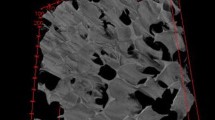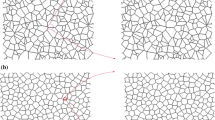Abstract
The effect of internal architecture on the mechanical properties of stochastic honeycombs was investigated by using four polypropylenes with varying rheological properties. The polymers were first characterized in terms of their thermal and mechanical properties, and then used to fabricate a set of stochastic honeycombs over a range of densities. The internal architecture was characterized by X-ray tomography, and the out-of-plane compressive properties of the stochastic honeycombs were determined. Overall, the strengths varied from 1 to 4 MPa over a core density range of 7–14 %. A thin-plate buckling model was developed to build a predictive strength model. This model was split into a material properties portion (dependent on the polymer stiffness) and an architectural portion (dependent on the fraction of bound webs in the honeycomb). The model was found to serve as a good first step towards predicting the strength of irregular honeycombs.








Similar content being viewed by others
References
Hostetter M, Cordner B, Hibbard GD (2012) Stochastic honeycomb sandwich cores. Compos B 43:1024–1029
Hostetter M, Hibbard GD (2014) Architectural characteristics of stochastic honeycombs fabricated from varying melt strength polypropylenes. J Appl Polym Sci 131:40074
Van Krevelen DW (2009) Properties of Polymers, Their Estimation and Correlation with Chemical Structure, 4th edn. Elsevier, New York
Galeski A (1999) Crystallization. In: Karger-Kocsis J (ed) Polypropylene: an A–Z guide. Kluwer, Dordrecht, pp 135–141
Maier C, Calafut T (1998) Polypropylene: the definitive user’s guide and databook. Plast Des Libr, Norwich
Ide F, Hasegawa A (1974) Studies on polymer blend of nylon 6 and polypropylene or nylon 6 and polystyrene using the reaction of polymer. J Appl Polym Sci 18:963–974
Svoboda P, Zeng C, Wang H, Lee LJ, Tomasko DL (2002) Morphology and mechanical properties of polypropylene/organoclay nanocomposites. J Appl Polym Sci 85:1562–1570
Natta G, Corradini P (1960) Structure and properties of isotactic polypropylene. Il Nuovo Cimento Ser 10:40–51
Nielsen AS, Batchelder DN, Pyrz R (2002) Estimation of crystallinity of isotactic polypropylene using Raman spectroscopy. Polymer 43:2671–2676
Asakawa H, Nishida K, Kanaya T, Tosaka M (2013) Giant single crystal of isotactic polypropylene showing near-equilibrium melting temperature. Polym J 45:287–292
Yamada K, Hikosaka M, Toda A, Yamazaki S, Tagashira K (2003) Equilibrium melting temperature of isotactic polypropylene with high tacticity. 2. Determination by optical microscopy. Macromolecules 36:4802–4812
Yamada K, Hikosaka M, Toda A, Yamazaki S, Tagashira K (2003) Equilibrium melting temperature of isotactic polypropylene with high tacticity: 1. Determination by differential scanning calorimetry. Macromolecules 36:4790–4801
Cheng SZD, Janimak JJ, Zhang A, Hsieh ET (1991) Isotacticity effect on crystallization and melting in polypropylene fractions: 1. Crystalline structures and thermodynamic property changes. Polymer 32:648–655
Nakamura K, Shimizu S, Umemoto S, Thierry A, Lotz B, Okui N (2008) Temperature dependence of crystal growth rate for α and β forms of isotactic polypropylene. Polym J 40:915–922
Fried JR (2003) Polymer science and technology, 2nd edn. Prentice Hall PTR, Upper Saddle River
CES Polymer Selector (2013) Granta material intelligence. Cambridge, UK
Perego G, Cella GD, Bastioli C (1996) Effect of molecular weight and crystallinity on poly(lactic acid) mechanical properties. J Appl Polym Sci 59:37–43
van der Wal A, Mulder JJ, Gaymans RJ (1998) Fracture of polypropylene: the effect of crystallinity. Polymer 39:5477–5481
Xu S, Beynon JH, Ruan D, Lu G (2012) Experimental study of the out-of-plane dynamic compression of hexagonal honeycombs. Compos Struct 94:2326–2336
Zhang J, Ashby MF (1992) The out-of-plane properties of honeycombs. Int J Mech Sci 34:475–489
Côté F, Deshpande VS, Fleck NA, Evans AG (2004) The out-of-plane compressive behavior of metallic honeycombs. Mater Sci Eng A 380:272–280
Aminanda Y, Castanié B, Barrau J, Thevenet P (2005) Experimental analysis and modeling of the crushing of honeycomb cores. Appl Compos Mater 12:213–227
Lee HS, Hong SH, Lee JR, Kim YK (2002) Mechanical behavior and failure process during compressive and shear deformation of honeycomb composite at elevated temperatures. J Mater Sci 37:1265–1272. doi:10.1023/A:1014344228141
Liang S, Chen HL (2006) Investigation on the square cell honeycomb structures under axial loading. Compos Struct 72:446–454
Domenico A, Ferdinando A, Costantino M, Simone M, Andrea P, Alessandro R (2013) Statistical finite element analysis of the buckling behavior of honeycomb structures. Compos Struct 105:240–255
Fan X, Verpoest I, Vandepitte D (2006) Finite element analysis of out-of-plane compressive properties of thermoplastic honeycomb. J Sandw Struct Mater 8:437–458
Hohe J, Beckmann C (2012) Probabilistic homogenization of hexagonal honeycombs with perturbed microstructure. Mech Mater 49:13–29
Silva MJ, Hayes WC, Gibson LJ (1995) The effects of non-periodic microstructure on the elastic properties of two-dimensional cellular solids. Int J Mech Sci 37:1161–1177
Zhu HX, Hobdell JR, Windle AH (2001) Effects of cell irregularity on the elastic properties of 2D Voronoi honeycombs. J Mech Phys Solids 49:857–870
Zhu HX, Thorpe SM, Windle AH (2006) The effect of cell irregularity on the high strain compression of 2D Voronoi honeycombs. Int J Solids Struct 43:1061–1078
Lee J, Choi JB, Choi K (1996) Application of homogenization FEM analysis to regular and re-entrant honeycomb structures. J Mater Sci 31:4105–4110. doi:10.1007/BF00352675
Silva MJ, Gibson LJ (1997) The effects of non-periodic microstructure and defects on the compressive strength of two-dimensional cellular solids. Int J Mech Sci 39:549–563
Albuquerque JM, Fátima Vaz M, Fortes MA (1999) Effect of missing walls on the compression behaviour of honeycombs. Scr Mater 41:167–174
Guo XE, Gibson LJ (1999) Behavior of intact and damaged honeycombs: a finite element study. Int J Mech Sci 41:85–105
Wang AJ, McDowell DL (2003) Effects of defects on in-plane properties of periodic metal honeycombs. Int J Mech Sci 45:1799–1813
Lautensack C, Sych T (2006) 3D Image analysis of open foams using random tesselations. Image Anal Stereol 25:87–93
Mecke KR (2000) Additivity, convexity, and beyond: applications of minkowski functionals in statistical physics. In: Mecke KR, Stoyan D (eds) Lecture notes in Physics vol 554. Springer, Berlin, pp 111–184
Frenkel G, Blumenfeld R, King PR, Blunt MJ (2009) Topological analysis of foams and tetrahedral structures. Adv Eng Mater 11:169–176
Schröder-Turk GE, Mickel W, Kapfer SC et al (2011) Minkowski tensor shape analysis of cellular, granular and porous structures. Adv Mater 23:2535–2553
Michielsen K, De Raedt H (2001) Integral-geometry morphological image analysis. Phys Rep 347:461–538
Ohser J, Mücklich F (2000) Statistical analysis of microstructures in materials science. Wiley, Chichester
Legland D, Kiêu K, Devaux MF (2007) Computation of Minkowski measures on 2D and 3D binary images. Image Anal Stereol 26:83–92
Mikos AG, Thorsen AJ, Czerwonka LA, Bao Y, Langer R, Winslow DN, Vacanti JP (1994) Preparation and characterization of poly(l-lactic acid) foams. Polymer 35:1068–1077
Kraynik AM, Reinelt DA, van Swol F (2004) Structure of random foam. Phys Rev Lett 93:208301
Lu L, Peter SJ, Lyman MD et al (2000) In vitro degradation of porous poly(l-lactic acid) foams. Biomaterials 21:1595–1605
Zeschky J, Hofner T, Arnold C, Weibmann R, Bahloul-Hourlier D, Scheffler M, Greil P (2005) Polysilsesquioxane derived ceramic foams with gradient porosity. Acta Mater 53:927–937
Bryan GH (1890) On the stability of a plane plate under thrusts in its own plane, with applications to the “buckling” of the sides of a ship. Proc Lond Math Soc 22:54–67
Gere JM, Timoshenko SP (1961) Theory of elastic stability, 2nd edn. McGraw-Hill, New York
Rinde JA (1970) Poisson’s ratio for rigid plastic foams. J Appl Polym Sci 14:1913–1926
Callister WD, Rethwisch DG (2008) Fundamentals of materials science and engineering: an integrated approach, 3rd edn. Wiley, Hoboken
Zihlif AM, Duckett RA, Ward IM (1978) The Poisson’s ratio of ultra-drawn polyethylene and polypropylene fibres using Michelson interferometry. J Mater Sci 13:1837–1840. doi:10.1007/BF00548754
Van Krevelen DW, Te Nijenhuis K (2009) Properties of polymers: their correlation with chemical structure; their numerical estimation and prediction from additive group contributions, 4th edn. Elsevier, Amsterdam
Allen HG, Bulson PS (1980) Background to buckling. McGraw-Hill Book Co., New York
Bloom F, Coffin D (2000) Handbook of thin plate buckling and postbuckling. Chapman & Hall/CRC, Boca Raton
Author information
Authors and Affiliations
Corresponding author
Rights and permissions
About this article
Cite this article
Hostetter, M., Hibbard, G.D. Modeling the buckling strength of polypropylene stochastic honeycombs. J Mater Sci 49, 8365–8372 (2014). https://doi.org/10.1007/s10853-014-8546-z
Received:
Accepted:
Published:
Issue Date:
DOI: https://doi.org/10.1007/s10853-014-8546-z




